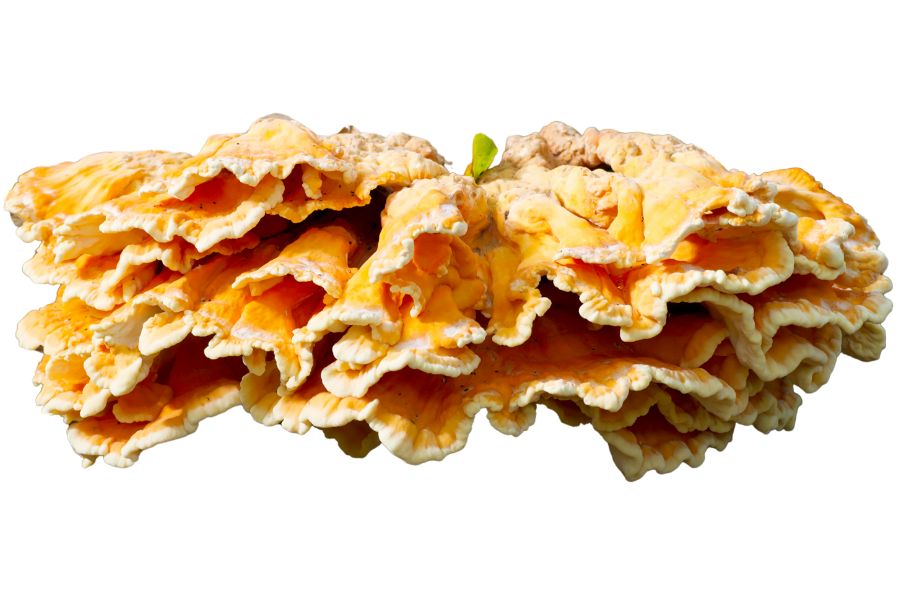Florida has plenty of wild mushrooms you can eat, and they aren’t always easy to find. You might catch a glimpse of a shaggy mane popping up near a trail or notice a cauliflower mushroom blending into the pine needles. The variety isn’t obvious until you’ve spent some time out there.
Some mushrooms are better known, but others stay under the radar even though they’re just as good. There are edible species that blend right into the forest floor if you don’t know what you’re looking for. Others grow high on old trees, hiding in plain sight.
Once you start spotting a few, it becomes clear how many kinds grow across different landscapes in the state. There’s a lot more to uncover once you know the signs to watch for. And knowing what to look for can lead to a basket filled with all kinds of edible surprises.
What We Cover In This Article:
- The Edible Mushrooms Found in the State
- Mushroom Lookalikes to Avoid
- Our Best Tips For Finding Edible Mushrooms
- Proven Locations For Foraging Mushrooms
- The Best Times of Year to Look
- The extensive local experience and understanding of our team
- Input from multiple local foragers and foraging groups
- The accessibility of the various locations
- Safety and potential hazards when collecting
- Private and public locations
- A desire to include options for both experienced foragers and those who are just starting out
Using these weights we think we’ve put together the best list out there for just about any forager to be successful!
A Quick Reminder
Before we get into the specifics about where and how to find these plants and mushrooms, we want to be clear that before ingesting any wild plant or mushroom, it should be identified with 100% certainty as edible by someone qualified and experienced in mushroom and plant identification, such as a professional mycologist or an expert forager. Misidentification can lead to serious illness or death.
All plants and mushrooms have the potential to cause severe adverse reactions in certain individuals, even death. If you are consuming wild foragables, it is crucial to cook them thoroughly and properly and only eat a small portion to test for personal tolerance. Some people may have allergies or sensitivities to specific mushrooms and plants, even if they are considered safe for others.
The information provided in this article is for general informational and educational purposes only. Foraging involves inherent risks.
The Edible Mushrooms Found in the State
Many types of edible mushrooms grow across the state, depending on the region and time of year. Some are easy to recognize, while others require a more experienced eye.
These are some of the most sought-after edible mushrooms that grow in different parts of the state:
Golden Chanterelle (Cantharellus cibarius)
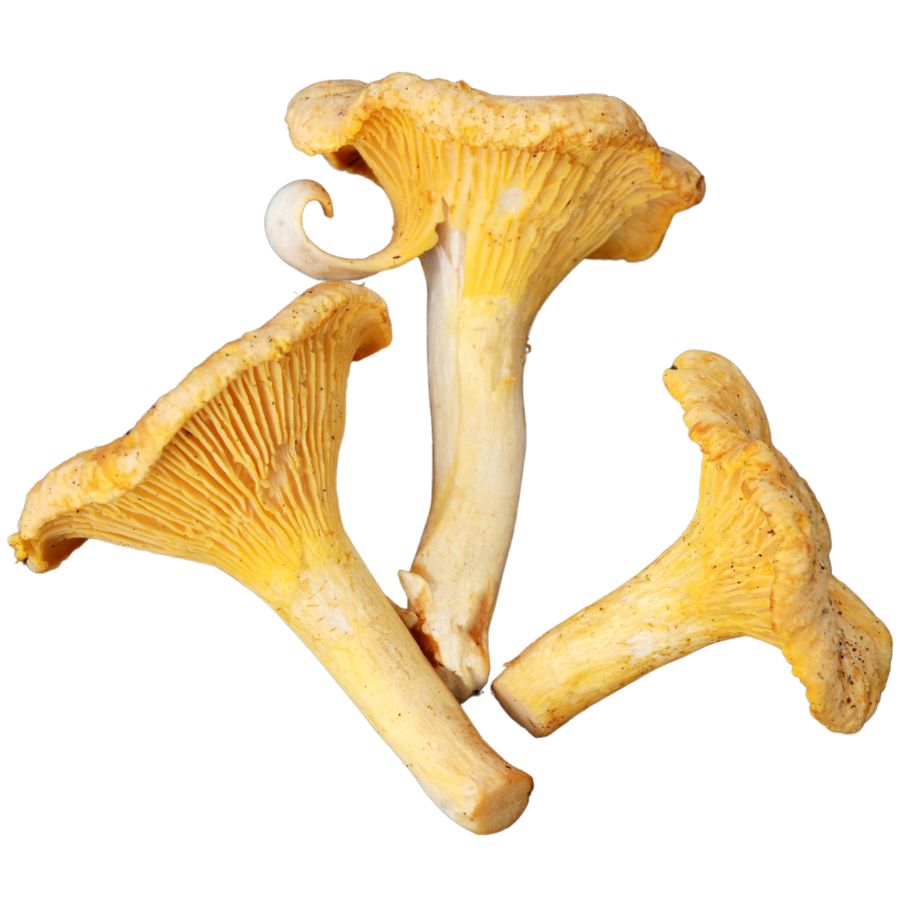
Golden chanterelles, also known as egg yolk mushrooms or forest gold, have a bright yellow to orange color with a funnel-shaped cap and thick, wavy edges. You’ll notice that the underside has shallow ridges instead of true gills, and they run down the stem.
A few toxic mushrooms look similar, including the jack-o’-lantern mushroom, which grows in clusters and has true gills that don’t fork or run down the stem. If you rub a chanterelle and it smells fruity or like apricots, that’s a good sign you’ve got the real thing.
The taste is mild, earthy, and a little peppery, with a firm but smooth texture that holds up well in cooking. Chanterelles are often sautéed in butter, added to cream sauces, or used in soups and egg dishes.
They don’t dry well, so you’ll want to use them fresh, or store them briefly in the fridge wrapped in paper. These mushrooms often grow in the same spots year after year, so if you find a patch, it’s worth checking again the next season.
Hedgehog Mushroom (Hydnum repandum)
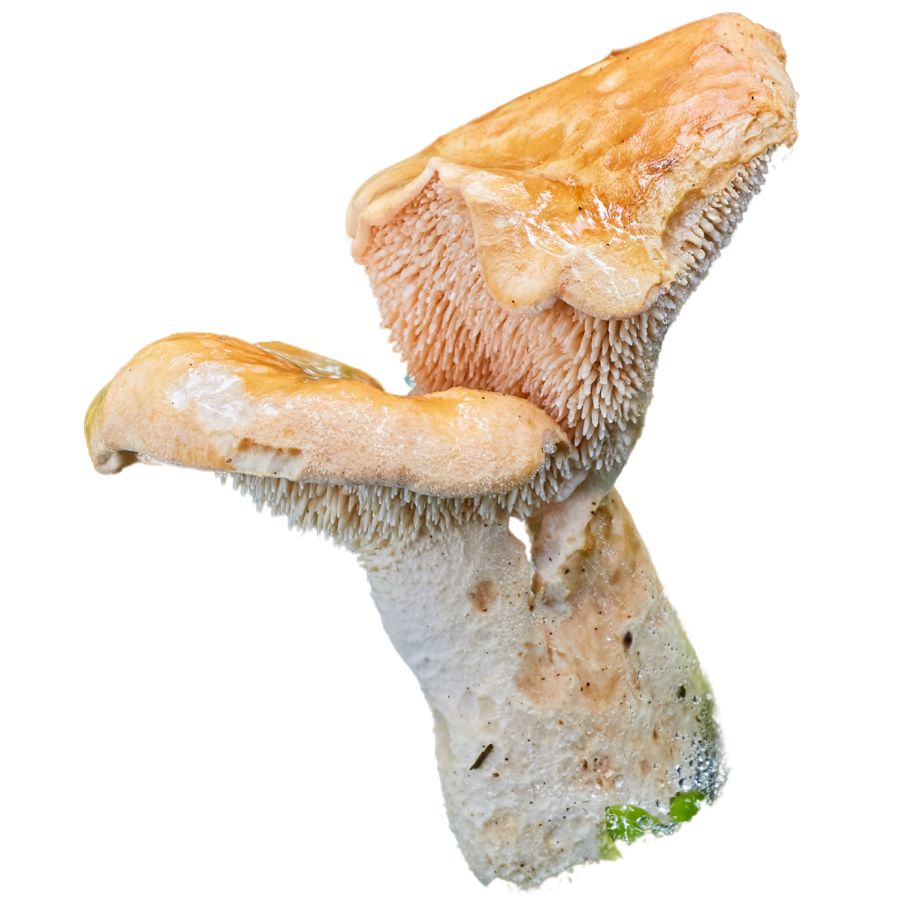
Hedgehog mushrooms are also called sweet tooth mushrooms, and they’re one of the easiest wild mushrooms to recognize. Instead of gills, the underside of the cap has soft, pale spines that resemble tiny teeth.
They’re usually creamy to light orange in color with thick, firm stems and a cap that can be wavy or lopsided. You’ll often find them growing in loose groups in mixed woodlands during the cooler months.
Their flavor is nutty and a little bit sweet, and the texture stays pleasantly firm even after cooking. They hold up well in sautés, stews, and even dry well for long-term storage without losing too much flavor.
Hedgehog mushrooms don’t have many toxic lookalikes, but you should still make sure you see those signature spines before collecting. They’re a great beginner-friendly mushroom and tend to be overlooked, which means you’re more likely to find some even in spots that have already been picked over.
Chicken of the Woods (Laetiporus sulphureus)

Chicken of the woods is also called sulfur shelf or chicken mushroom, and it’s hard to miss with its bright orange and yellow shelves growing on tree trunks. It usually grows in overlapping clusters and can get quite large, often covering whole sections of wood.
The texture is tender when young and becomes tougher as it ages, so try to harvest it early. It has a mild, meaty flavor that many people say reminds them of chicken, especially when cooked.
Make sure to watch out for lookalikes like the jack-o’-lantern mushroom, which also grows on wood and has an orange color. The big difference is that jack-o’-lanterns have gills rather than pores underneath and can cause serious stomach issues if eaten.
People usually sauté or fry chicken of the woods, but it can also be frozen after cooking for later use. Some people have mild reactions to it, especially when it’s old or eaten raw, so start with a small amount if it’s your first time.
Oyster Mushroom (Pleurotus ostreatus)
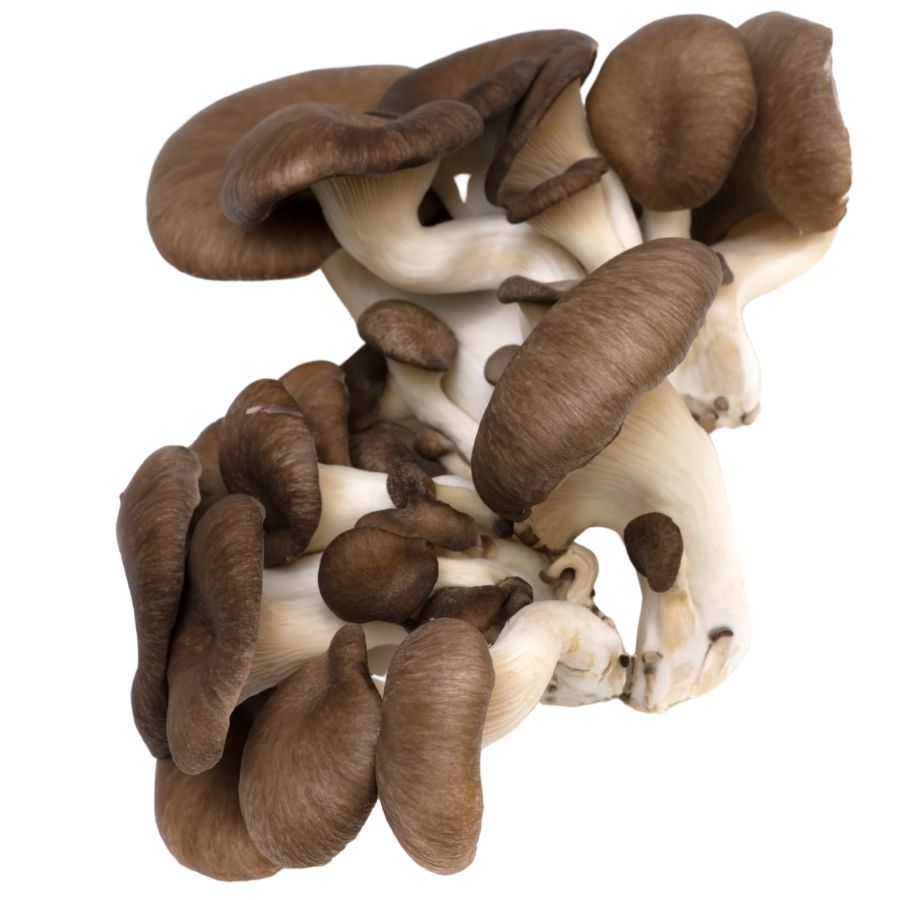
Oyster mushrooms are also called tree oysters or pearl oysters, and they’re known for their wide, shelf-like caps that resemble oyster shells. They usually grow in clusters on dead or dying hardwood and come in shades of white, gray, or pale brown, with creamy white gills that run down the stem.
You can recognize them by their smooth, fan-shaped caps and their mild, anise-like scent. One common lookalike is the toxic jack-o’-lantern mushroom, which grows in clumps like oysters but has orange coloring and glows faintly in the dark.
Oyster mushrooms have a soft, slightly chewy texture and a delicate, savory flavor that works well in stir-fries, soups, or simply sautéed in butter. They’re also good for drying or freezing, and some people pickle them to enjoy later in the season.
These mushrooms are used in some parts of the world for medicinal purposes and even in research for breaking down pollutants. While they’re generally safe to eat, they can cause digestive issues in some people if undercooked, so make sure to cook them thoroughly before eating.
Meadow Mushroom (Agaricus campestris)
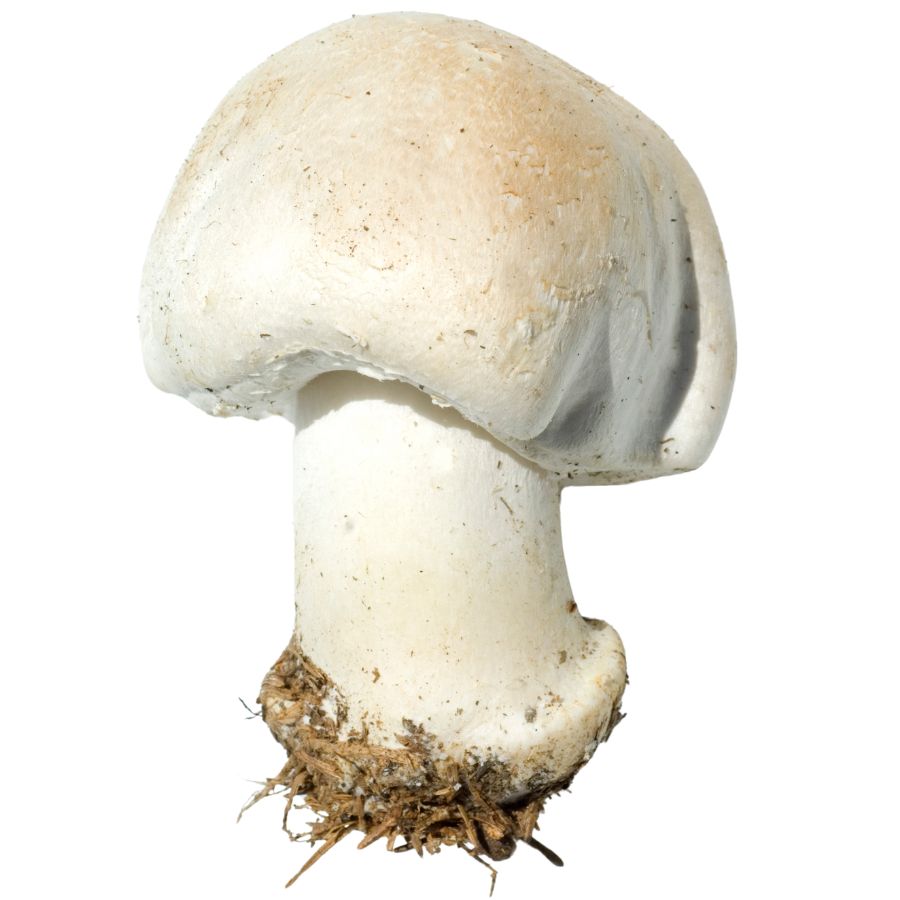
Meadow mushrooms are sometimes called pink bottoms or field mushrooms. They usually have a smooth white cap that stays round before flattening out as they mature, with pale pink gills that darken to chocolate brown.
You’ll want to double-check before harvesting because they can look a lot like some toxic Amanitas. One of the easiest ways to tell them apart is by the gill color and the strong, pleasant mushroom smell meadow mushrooms have.
These mushrooms have a mild, nutty flavor and a firm texture that holds up well in cooking. You can sauté them, add them to stews, or even dry them for later use.
Some people with mushroom sensitivities might react to them, especially when they’re eaten raw. Always cook meadow mushrooms thoroughly and avoid harvesting them from areas with chemical exposure like lawns or roadsides.
Lion’s Mane (Hericium erinaceus)

Lion’s mane, also called bearded tooth or pom pom mushroom, is easy to spot thanks to its cascading white spines that look a bit like a frozen waterfall. It usually grows on dead or dying hardwood trees and forms round, shaggy clumps that almost glow against the bark.
If you’re checking for lookalikes, you might run into other Hericium species like bear’s head or comb tooth, but none of them are toxic. Just make sure the spines are soft, white, and at least a quarter inch long, and avoid anything discolored or slimy.
Lion’s mane has a firm, meaty texture and a mild flavor that some people say reminds them of seafood, especially crab or lobster. You can sauté it, roast it, or even shred it as a meat substitute in sandwiches and tacos.
Some people also dry lion’s mane or take it as a supplement, since it’s being studied for possible benefits to memory and focus. There aren’t any serious safety concerns with eating it, but it’s still best to cook it thoroughly and start with a small amount the first time.
Gem-Studded Puffball (Lycoperdon perlatum)

The gem-studded puffball, also known as the common puffball or warted puffball, has a rounded white shape covered in tiny spiny bumps that rub off easily. It’s usually about the size of a golf ball, and when young, the inside is solid white and firm to the touch.
Once it starts to age and turn yellow or brown inside, it’s no longer good to eat. A toxic lookalike to watch out for is the immature form of the deadly amanita, which can also be round and white when young but has a developing cap and stem structure inside if sliced open.
The flavor is mild and earthy, and the texture is soft when cooked. Most people sauté it fresh, slice it into soups, or coat it in batter and fry it like nuggets.
Always make sure the interior is pure white before cooking. This mushroom is edible only in its young stage, and once it matures and fills with dark spores, it should be avoided.
Yellowfoot (Craterellus tubaeformis)
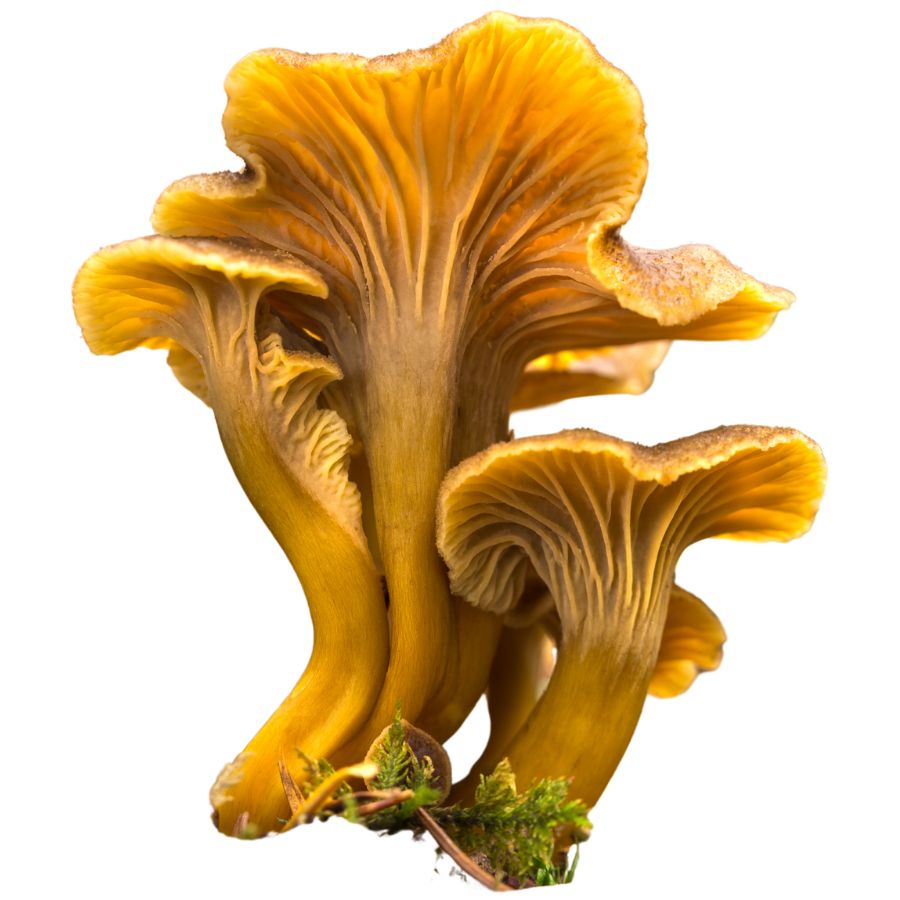
You might hear yellowfoot mushrooms called winter chanterelles or funnel chanterelles. They’re slender and trumpet-shaped, with brownish caps that curl inward and hollow yellow stems that help them stand out on the forest floor.
They’re often confused with some brownish Omphalotus or Galerina species, which are toxic, but yellowfoot have blunt-edged false gills that look more like wrinkles than true gills. Always double-check that the cap is smooth and the stem is hollow before collecting them.
Yellowfoot mushrooms have a delicate, fruity aroma and a mild, earthy flavor that holds up well in soups, risottos, and sautés. Their thin texture means they dry quickly and rehydrate easily, making them great for storing and using later.
These mushrooms often grow in clusters in damp conifer forests, especially during cooler months when other edible mushrooms are hard to find. If you’re out foraging and come across a patch, you’ll usually find a lot more nearby, so they’re worth seeking out.
Ringless Honey Mushroom (Armillaria tabescens)
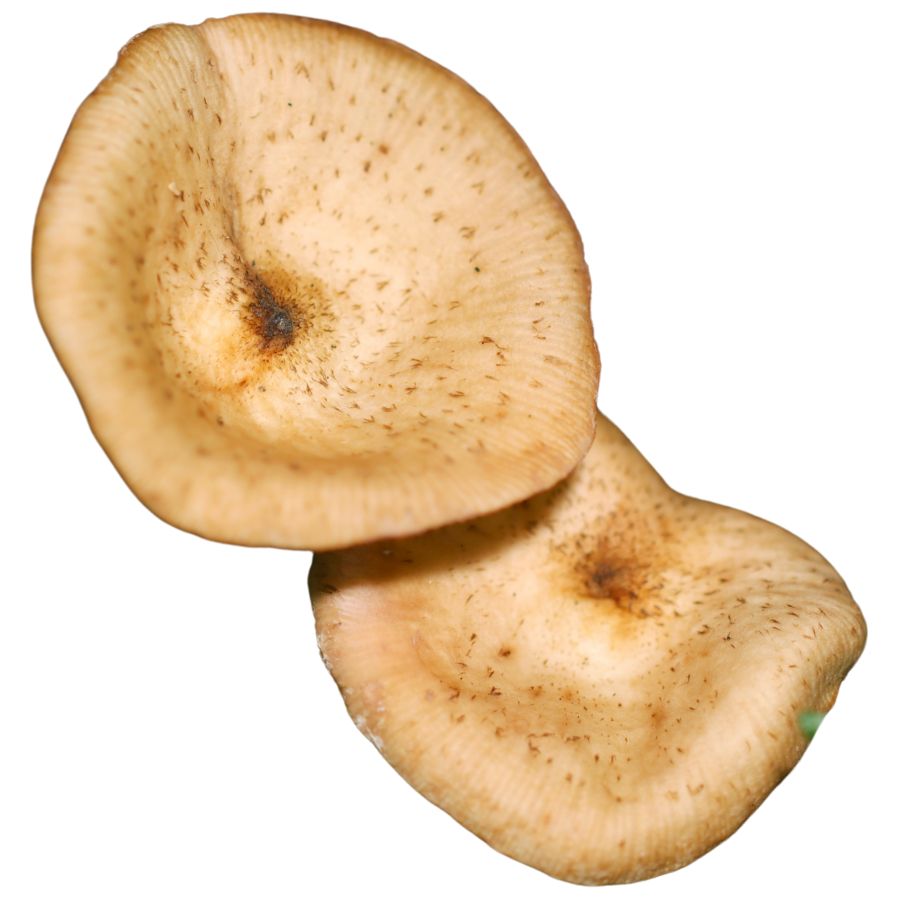
Ringless honey mushrooms grow in tight clusters around the base of hardwood trees, often forming large, fused clumps. Their tan to honey-colored caps are smooth, and the gills run slightly down the stem, which lacks the ring that gives them their name.
Some poisonous Galerina species can look similar, especially when young. You can tell them apart by checking for a ring on the stem and by noting that Galerina usually grow on rotting wood, not living trees.
These mushrooms have a firm, chewy texture and a mild, earthy flavor when cooked. People usually sauté or parboil them before adding them to soups or stews, and they’re often dried for later use.
Ringless honey mushrooms should always be cooked thoroughly, as eating them raw or undercooked can cause stomach upset. Some people may still have a reaction even after cooking, so it’s best to try a small amount first.
Shaggy Mane (Coprinus comatus)
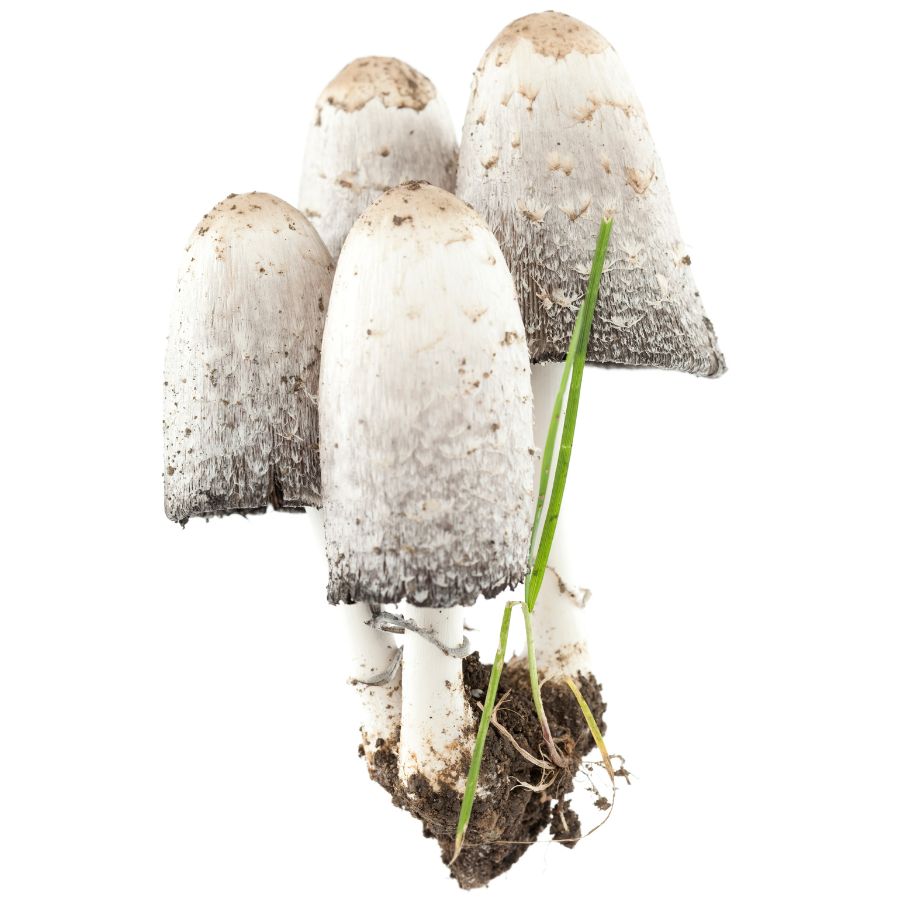
Shaggy mane mushrooms are also known as lawyer’s wig thanks to their tall, cylindrical caps covered in shaggy white scales. They often appear in lawns, meadows, or along roadsides and are most common after rain in cooler months.
These mushrooms are easy to recognize when fresh, but they quickly start to “melt” into a black, inky liquid as they age. That process, called deliquescence, is one of the main features that separates them from lookalikes like the inedible inky caps which are usually smaller and darker from the start.
Shaggy manes have a mild, pleasant flavor and a tender texture when cooked, but they don’t store well so you’ll want to use them the same day you pick them. Many people enjoy them sautéed, added to omelets, or mixed into cream-based sauces.
You shouldn’t eat shaggy manes with alcohol, since some people report reactions similar to those caused by certain inky caps. They’re one of the few mushrooms that actually taste best before the cap opens fully, so harvest them while they still look like white rockets.
Pear-Shaped Puffball (Lycoperdon pyriforme)

Pear-shaped puffballs are small, round mushrooms that taper near the base, giving them their name. They often grow in clusters on decaying wood and have a soft, tan to brown outer skin that eventually opens to release spores.
One of the easiest ways to tell them apart from toxic lookalikes is by slicing one open. If the inside is pure white and firm, it’s still edible; anything yellowing, gray, or developing a spore mass should be avoided.
When cooked, pear-shaped puffballs have a mild flavor and a soft, slightly chewy texture. They’re usually sautéed in butter or added to stir-fries and soups, and some people even bread and fry them.
Make sure to harvest them when they’re young and solid inside.
These puffballs are also sometimes used in folk practices to help stop minor bleeding, though that isn’t a substitute for proper medical care.
Comb Tooth (Hericium coralloides)

Comb tooth mushrooms are sometimes called coral tooth or cascading hedgehog, and they really do look like a frozen waterfall of white icicles. Each branch is covered in soft, dangling spines that hang downward in delicate clusters.
There are very few lookalikes, but it’s important not to confuse this with decaying white fungus or certain mold-like growths that form on rotting wood. Comb tooth always grows in an organized, coral-like pattern, and the spines should feel soft, never slimy.
When cooked, this mushroom has a texture similar to crab or scallops and takes on a mild, nutty flavor. It holds up well in stir-fries, soups, or even sliced thick and seared like seafood.
Some people dehydrate comb tooth to preserve it, while others freeze it after lightly sautéing. It’s also been studied for its potential benefits to nerve health, though it’s mainly prized for its taste and texture.
Puffball (Calvatia gigantea)
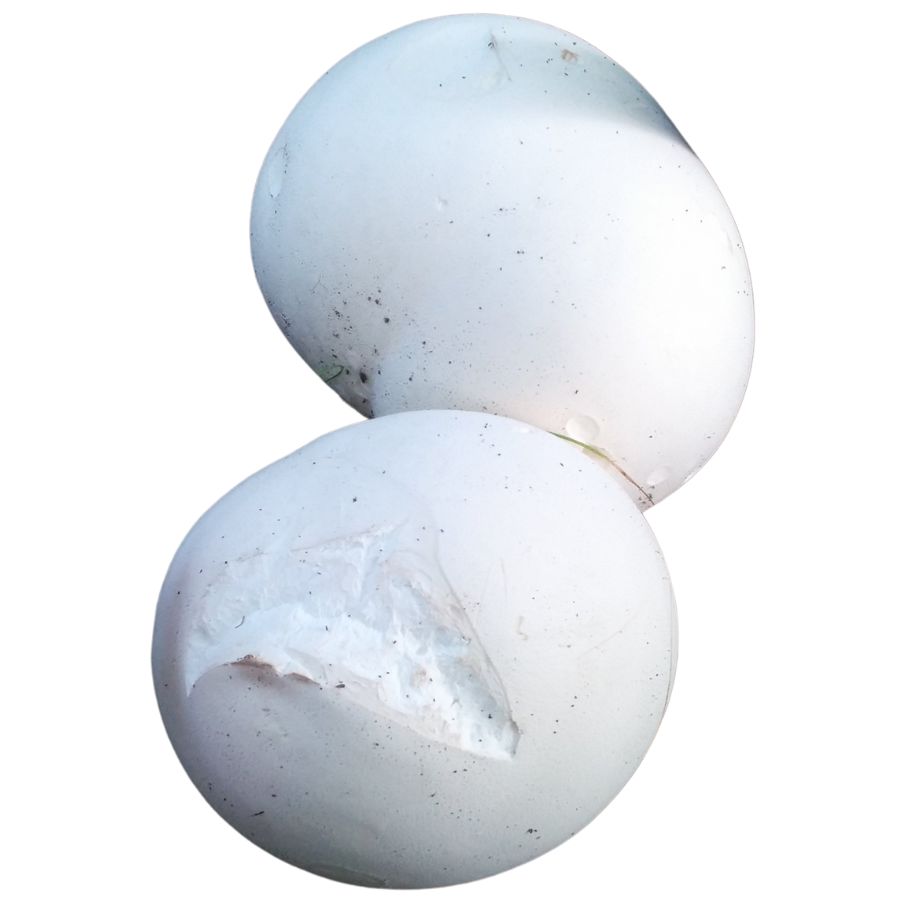
Puffball mushrooms, also called giant puffballs, look like big white balls sitting in the grass. They can grow larger than a soccer ball and have smooth, rounded exteriors with no visible gills or stems when sliced open.
To safely identify one, cut it in half vertically. The inside should be pure white and solid all the way through, with no signs of gills, caps, or any developing mushroom shape.
They have a mild, earthy flavor and a soft texture when cooked. People usually slice and pan-fry them, or use them in soups and egg dishes for a meaty texture.
Be cautious not to confuse them with immature Amanita mushrooms, which are deadly. Any puffball with a developing cap or that isn’t pure white inside should be avoided completely.
Field Blewit (Lepista saeva)

Field blewit, also called blue-leg or blue stalk, is a chunky mushroom with a pale tan to lilac cap and thick purplish stem. The gills are close together and start off light but turn a pinkish-buff color as the mushroom matures.
Its closest lookalikes include some Cortinarius species that are toxic, but those usually have rusty brown spores instead of pale pink. A good way to tell field blewit apart is by its sturdy build and the faintly fruity smell, which the toxic ones don’t have.
When cooked, field blewits have a rich, earthy flavor and a smooth, meaty texture. They hold up well in soups, sautés, and even risottos, especially when paired with garlic or herbs.
You should always cook this mushroom before eating it because it can cause digestive upset if eaten raw. It’s also best to avoid older specimens, which can spoil quickly and become slimy or bitter.
American Caesar’s Mushroom (Amanita jacksonii)

American Caesar’s mushrooms are also called Eastern Caesar’s or Jackson’s slender Caesar. They stand out with their bright orange to red caps, yellow gills, and long, slender yellow stems that rise from a white sac-like cup at the base.
These mushrooms are closely related to the European Caesar’s mushroom but grow in eastern parts of North America. Be careful, though, as some deadly Amanitas like the Destroying Angel start out looking similar in the egg stage. However, they lack the vibrant colors of American Caesar’s.
When cooked, they have a smooth, slightly nutty flavor and a tender texture that holds up well when sautéed or grilled. Some people enjoy them raw in small amounts, but cooking is the safest and most common way to eat them.
Stick to foraging these only when you’re absolutely sure of their identity, because confusion with toxic Amanitas can be fatal. If you know what to look for, though, finding these mushrooms can be a rewarding and delicious experience.
Common Split Gill (Schizophyllum commune)
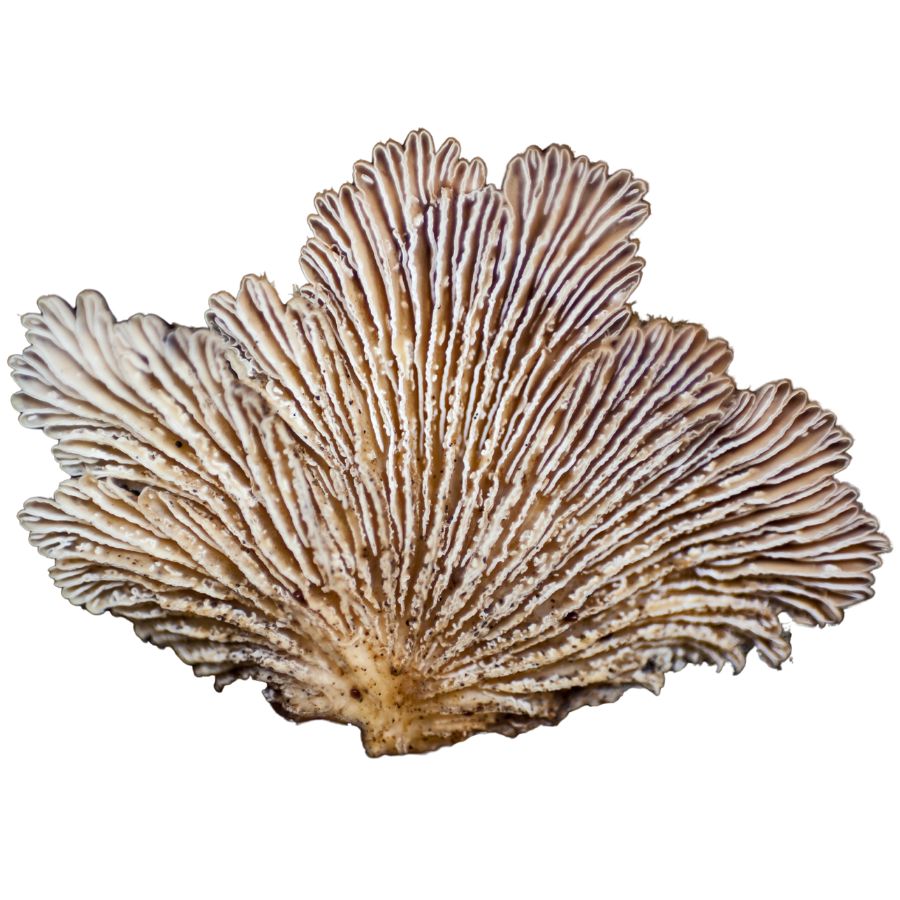
Common split gill, also known as split gill fungus or splitgill mushroom, has a fan-shaped cap that’s typically white, gray, or tan. The underside has distinctive gills that appear to be split down the middle, especially when dry or mature.
It grows in clusters on decaying wood and can look like some types of turkey tail or other shelf fungi, but those don’t have the split gill structure. When it’s fresh and moist, the gills can appear fused or wavy, but once dried, the splits become much more obvious.
The texture is tough and rubbery, so it’s not usually eaten fresh. In some cultures, it’s dried and later rehydrated to add to soups or broths where it holds its shape well and adds chewiness.
Even though it’s considered edible in some parts of the world, it’s not widely eaten, so try it in small amounts first if you plan to cook with it.
This mushroom is also used in scientific research because it can digest wood and has some medicinal properties under study.
The Prince (Agaricus augustus)
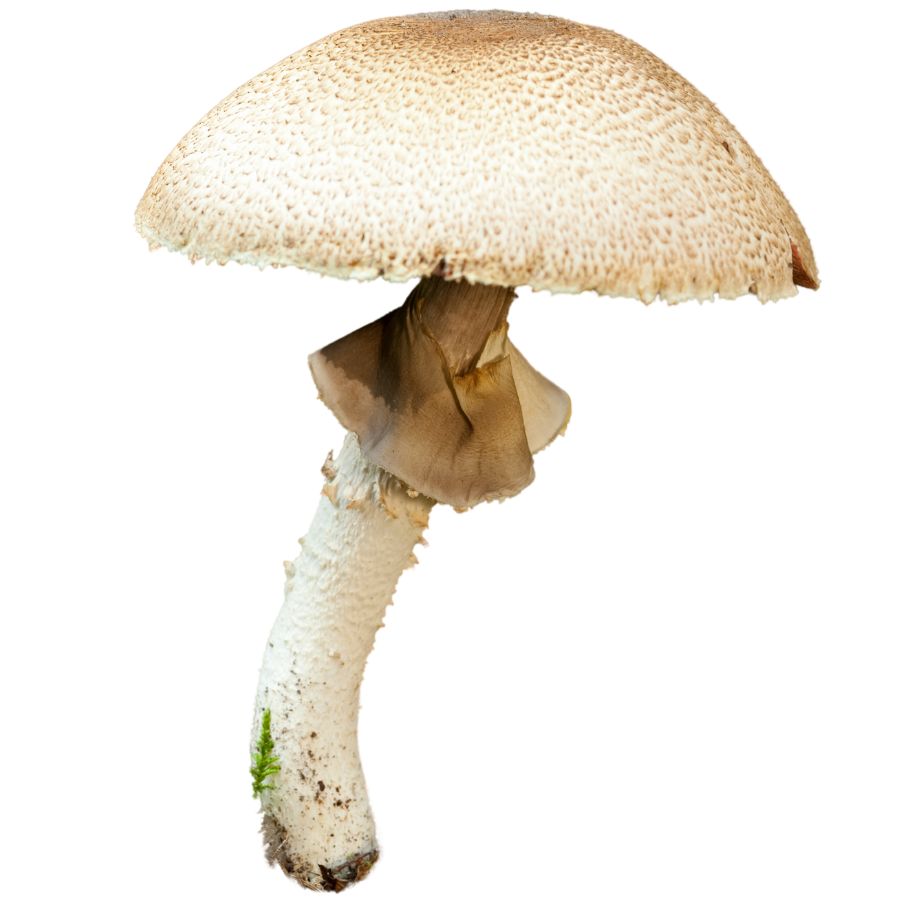
The prince is a large, showy mushroom that’s also known as the almond mushroom. It has a thick white stem and a cap covered in brownish scales, and it gives off a sweet, almond-like smell when it’s fresh.
You can tell it apart from toxic lookalikes like the yellow-staining Agaricus by cutting the base and checking for any bright yellow bruising. The prince will slowly stain a pale brown and not produce that strong inky or chemical smell that some inedible species do.
It has a rich, meaty flavor that many people compare to portobellos but with a sweeter finish. You can grill it, roast it, or slice it into pasta and risottos where its texture really stands out.
This mushroom can grow surprisingly large, sometimes big enough to fill a dinner plate. Just make sure to harvest young, firm specimens because older ones can get soggy and lose their flavor.
Witches’ Butter (Tremella mesenterica)
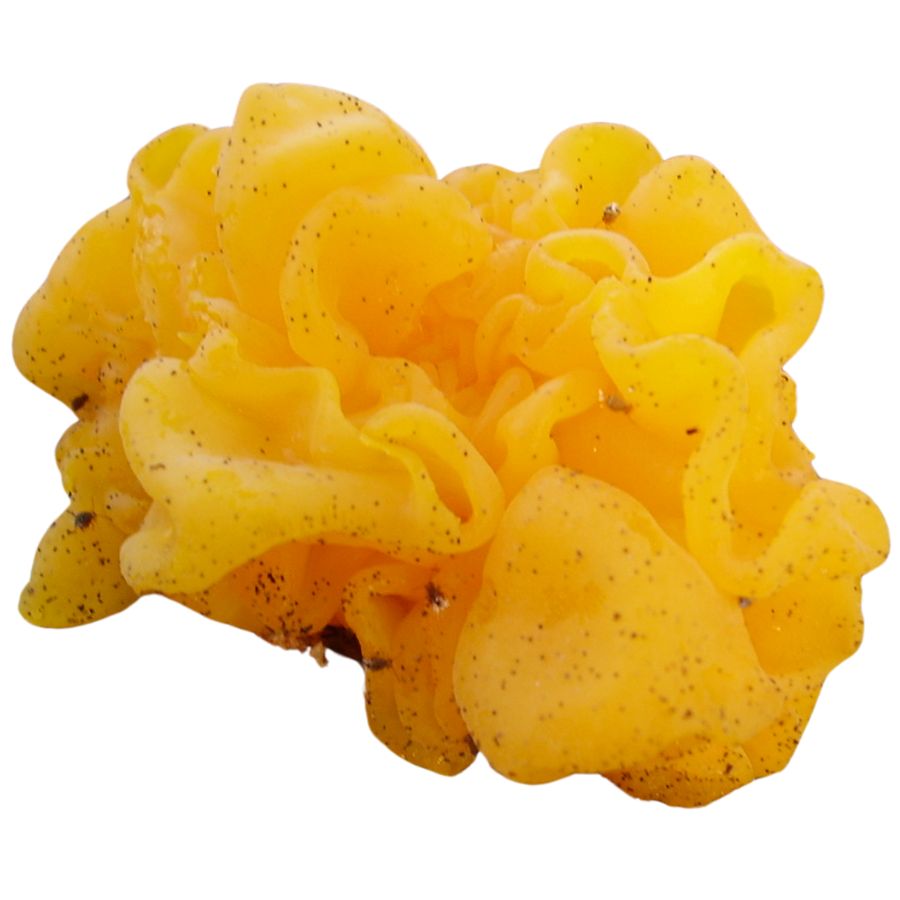
Witches’ butter, also known as golden jelly fungus or yellow brain, looks like a blob of bright orange or yellow jelly stuck to dead wood. It often shows up after rain, clinging to fallen branches or decaying logs, especially on hardwoods like oak or beech.
Its wobbly, gelatinous shape can be confused with orange jelly spot or golden ear, but those grow on conifers or have different textures. Witches’ butter stays soft and rubbery when moist, while its lookalikes tend to be tougher or more brittle.
The texture is more interesting than the taste, which is basically neutral. It’s sometimes added to soups or stir-fries in small amounts, where it soaks up flavor and adds a slippery crunch.
It’s edible, but not widely eaten for its flavor, and some people skip it altogether. Still, it’s fun to find, and some folks even use it in teas or tinctures out of tradition more than taste.
Wood Ear (Auricularia americana)
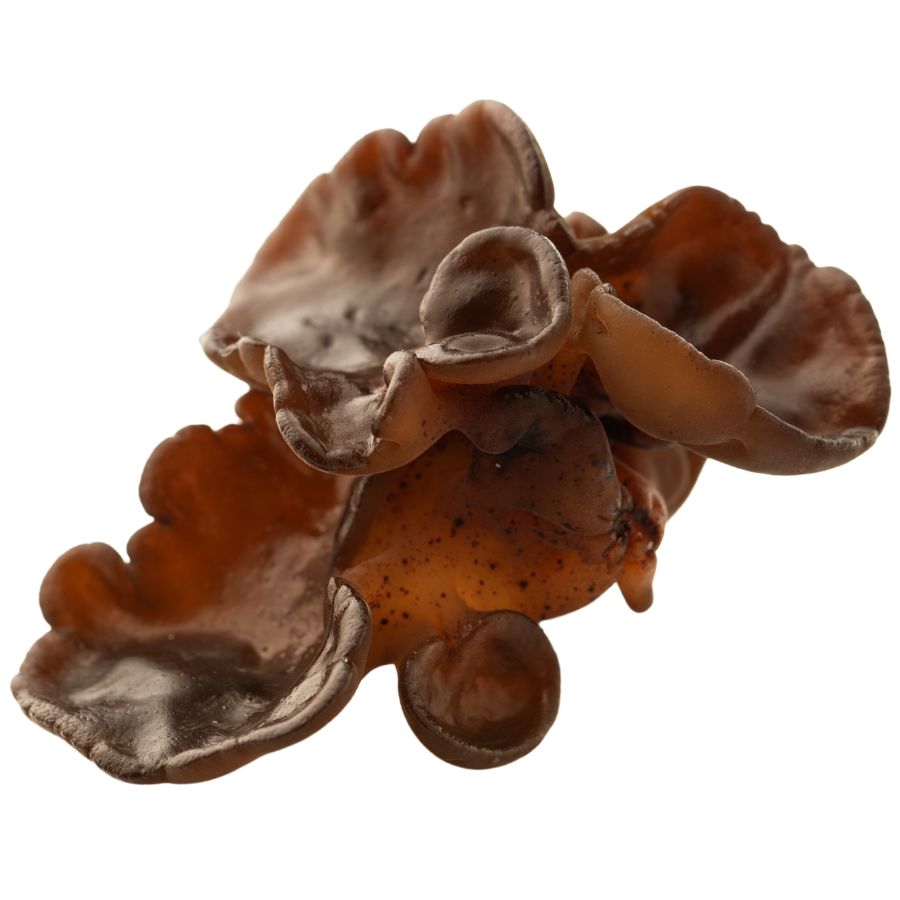
Wood ear mushrooms are also known as tree ears or jelly ears because of their thin, rubbery texture and ear-like shape. They grow on decaying hardwood, especially after rain, and range in color from dark brown to black with a slight sheen.
These mushrooms have a smooth surface and a flexible, jelly-like feel that sets them apart from dry or brittle lookalikes. They’re often mistaken for Exidia species, which are usually darker and don’t have the same cup-like shape or elasticity.
If you’re collecting them wild, always make sure they’re not growing on conifers or eucalyptus, as those can make them unsafe to eat.
Wood ears are prized more for their texture than flavor, which is mild and neutral. They hold up well in stir-fries, soups, and broths where their slight crunch adds a satisfying contrast.
They’re sometimes dried and rehydrated before cooking, which gives them a long shelf life.
Black Trumpet (Craterellus fallax)

Black trumpet mushrooms are also known as horn of plenty, trumpet of death, and black chanterelle. They have thin, wavy edges and a hollow, funnel-shaped body that’s usually charcoal to sooty black in color.
They don’t have gills, which helps you tell them apart from toxic lookalikes like some species of Omphalotus. The inner surface is smooth or slightly wrinkled, and the outer surface often looks dry and velvety.
They have a rich, earthy flavor with a smoky, almost nutty aroma when dried. Their texture is delicate when fresh and slightly chewy once cooked, which makes them great in pasta, soups, and risottos.
A lot of people prefer to dry black trumpets because it intensifies the flavor and makes them easy to store. Just pay more attention when collecting them, since their dark color makes them easy to miss on the forest floor.
Edible Mushroom Lookalikes to Avoid
It’s easy to confuse edible mushroom species with toxic ones that look surprisingly similar. Here’s a rundown of common mushroom lookalikes that you should learn to recognize and avoid.
Death Cap (Amanita phalloides)
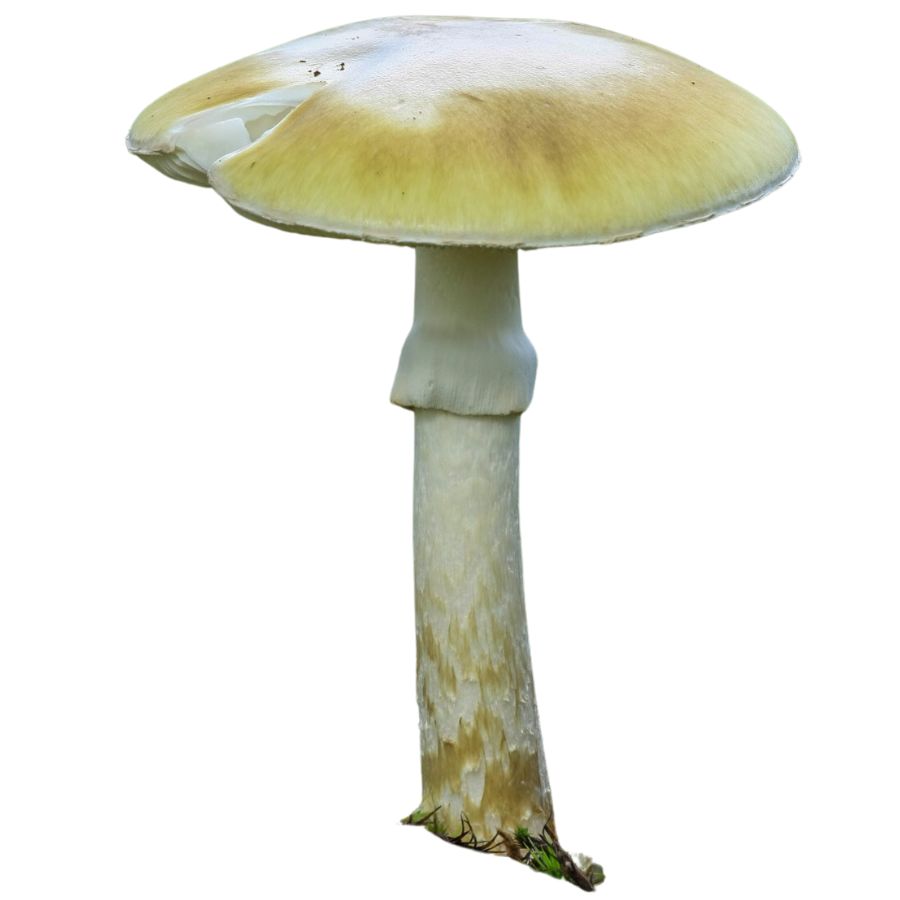
Often mistaken for: Paddy straw mushroom (Volvariella volvacea)
This deadly mushroom isn’t native but has naturalized in several parts of the US, especially California. It has a pale greenish or yellowish mushroom with a smooth, rounded cap and white gills underneath. It has a bulbous base often hidden underground and a delicate, skirt-like ring around the upper stem.
What makes the death cap dangerous is its amatoxins, which can cause liver and kidney failure even in small amounts. Symptoms may not show up for hours, and by then, serious damage may already be done—making this one of the deadliest mushrooms in the country.
False Morel (Gyromitra spp.)
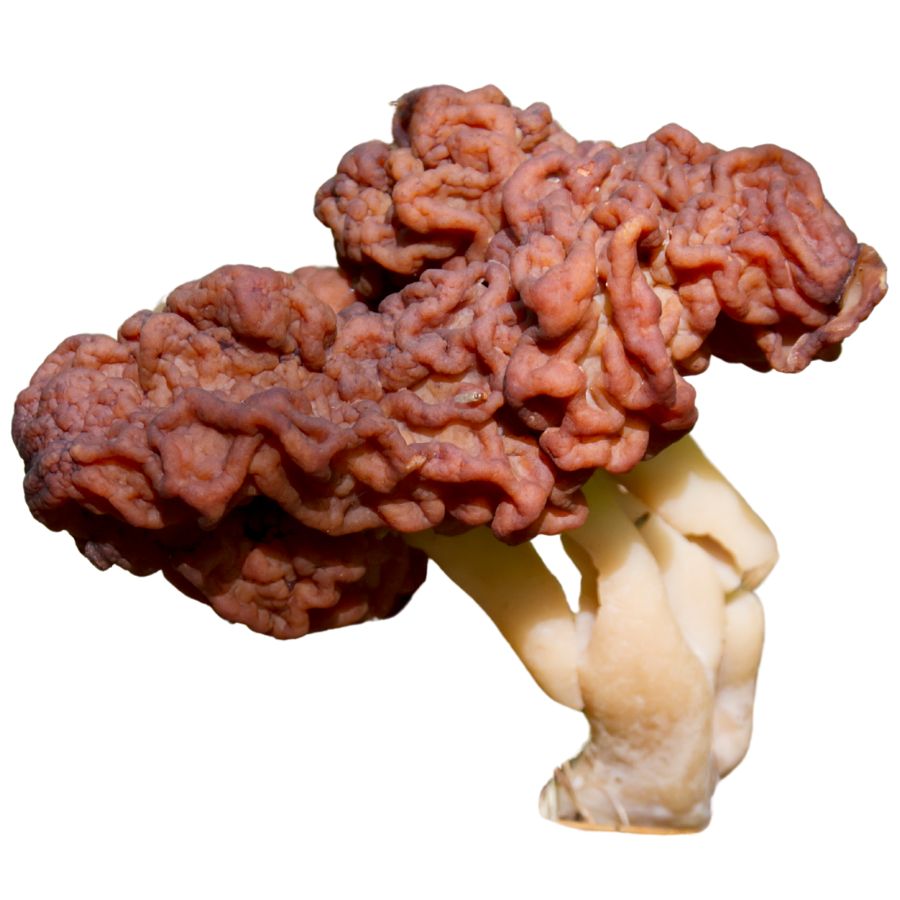
Often mistaken for: True morels (Morchella spp.)
False morels have wrinkled, lobed caps that look a bit like a brain or saddle, often reddish-brown or dark chestnut in color. Unlike true morels, their caps are usually irregular and hang over a thick, sometimes chambered stem.
These mushrooms contain toxic compounds like gyromitrin, which can turn into a chemical used in rocket fuel once inside the body. Eating them can lead to nausea, dizziness, seizures, or even liver failure in severe cases.
Jack-O’-Lantern (Omphalotus illudens)
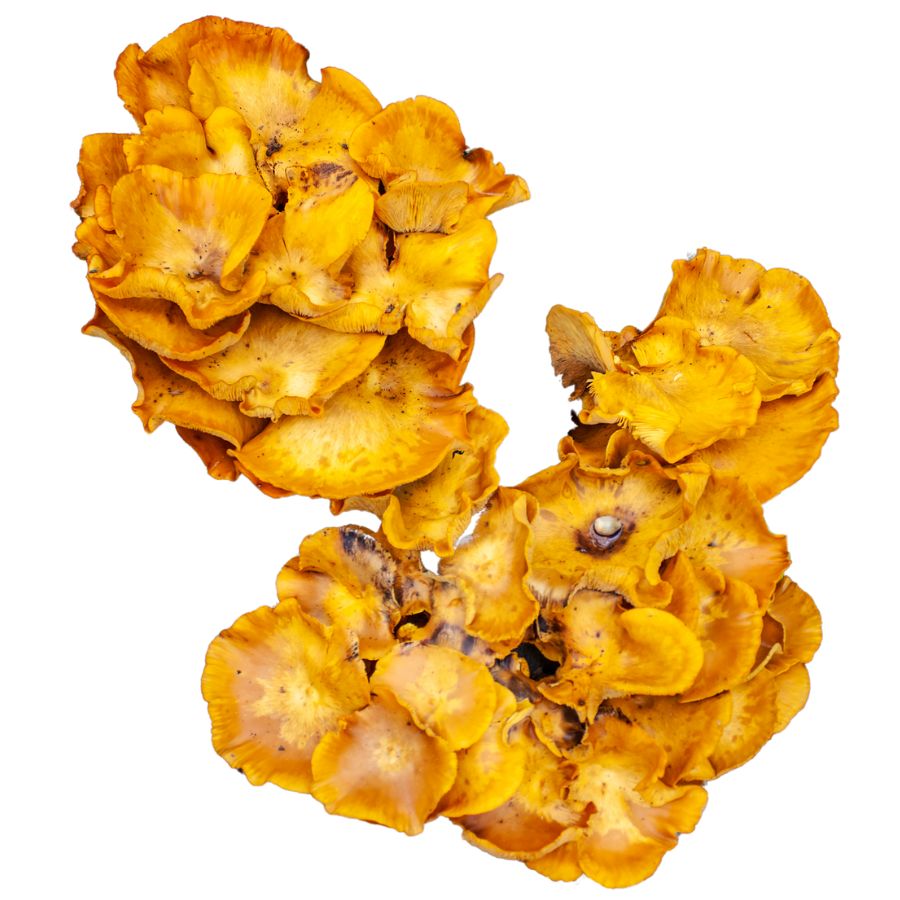
Often mistaken for: Chanterelles (Cantharellus spp.)
The jack-o’-lantern is a bright orange mushroom that grows in tight clusters, usually on decaying wood or buried tree roots. Its gills run down the stem and sometimes glow faintly in the dark due to natural bioluminescence.
These mushrooms are toxic and can cause severe stomach cramps, vomiting, and diarrhea. While not deadly, the symptoms can last for more than a day and are intense enough to require medical attention.
Green-Spored Parasol (Chlorophyllum molybdites)
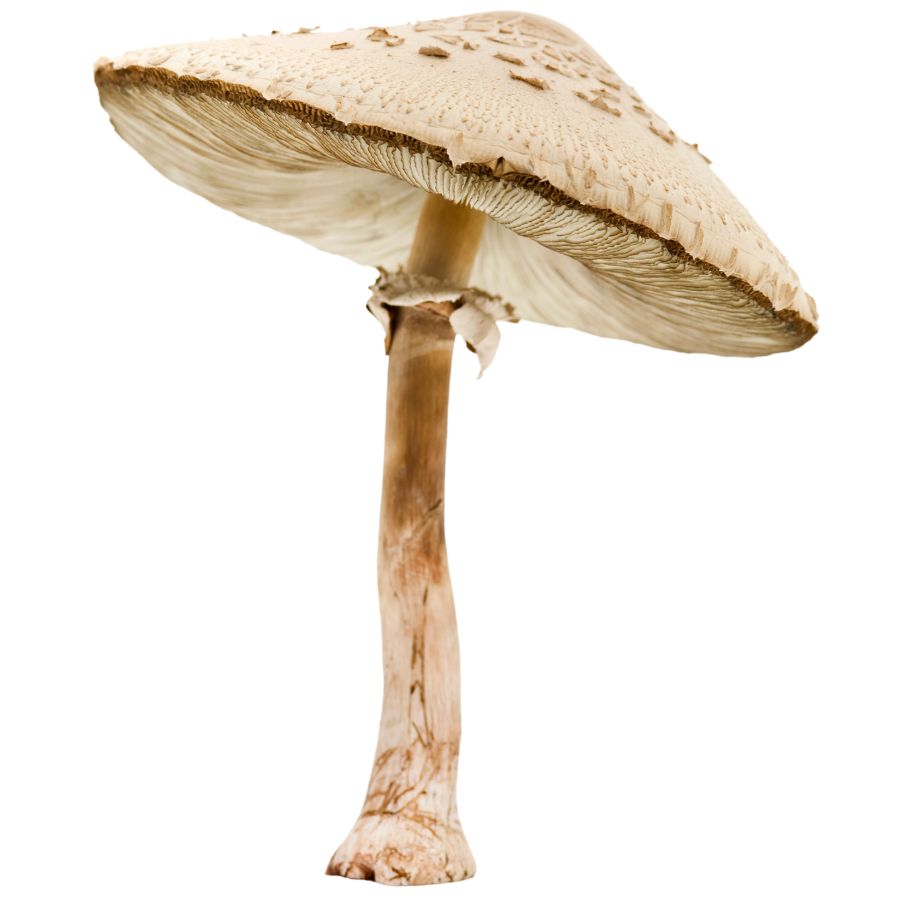
Often mistaken for: Meadow mushrooms (Agaricus campestris)
The green-spored parasol is a large, white mushroom with a wide, flat cap covered in brownish scales and a thick stem with a noticeable ring. When mature, its gills turn grayish-green and drop a green spore print, which is one of its most recognizable features.
This mushroom is toxic and causes intense gastrointestinal distress, including vomiting and diarrhea that can last for hours. While not fatal, it’s one of the most commonly reported causes of mushroom poisoning in the United States.
Eastern Destroying Angel (Amanita bisporigera)
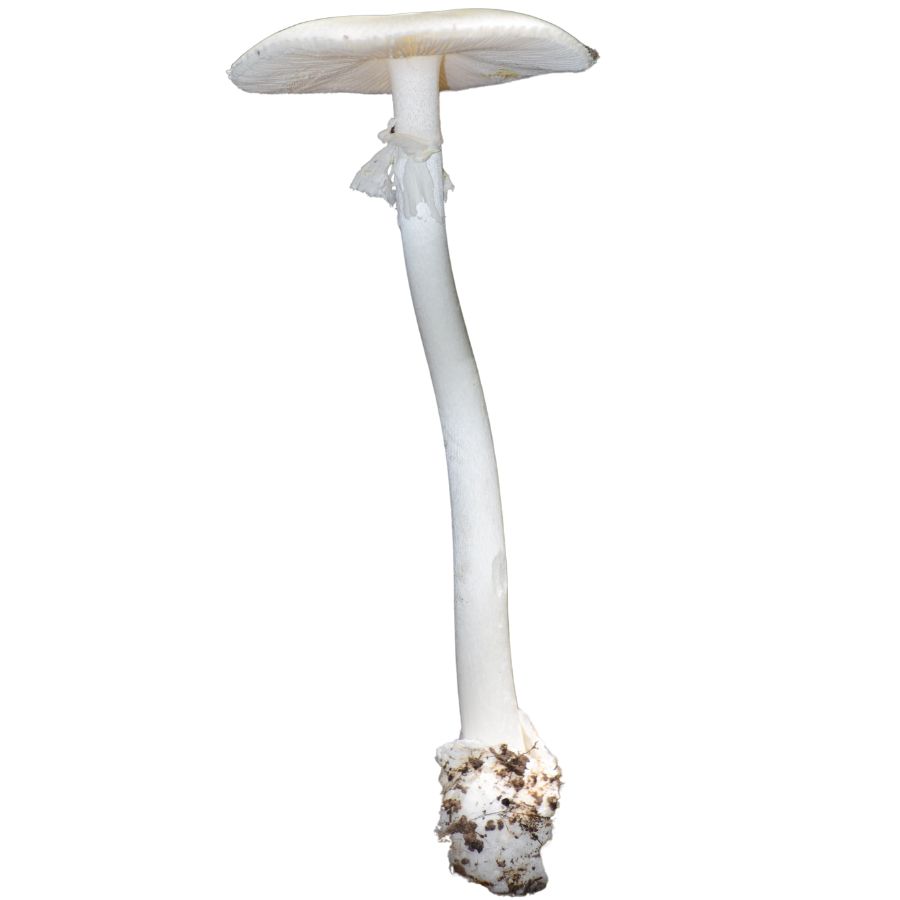
Often mistaken for: Young button mushrooms (Agaricus spp.)
The eastern destroying angel is a pure white mushroom with a smooth cap, white gills, and a slender stem that ends in a swollen base wrapped in a cup-like sac. It also has a thin ring near the upper part of the stem, a feature common to many toxic Amanitas.
What makes this mushroom so dangerous is its amatoxins, which attack the liver and kidneys and can be fatal if not treated quickly. Just one cap is enough to cause severe organ failure, and symptoms may take hours to appear.
Lilac Brown Cort (Cortinarius traganus)
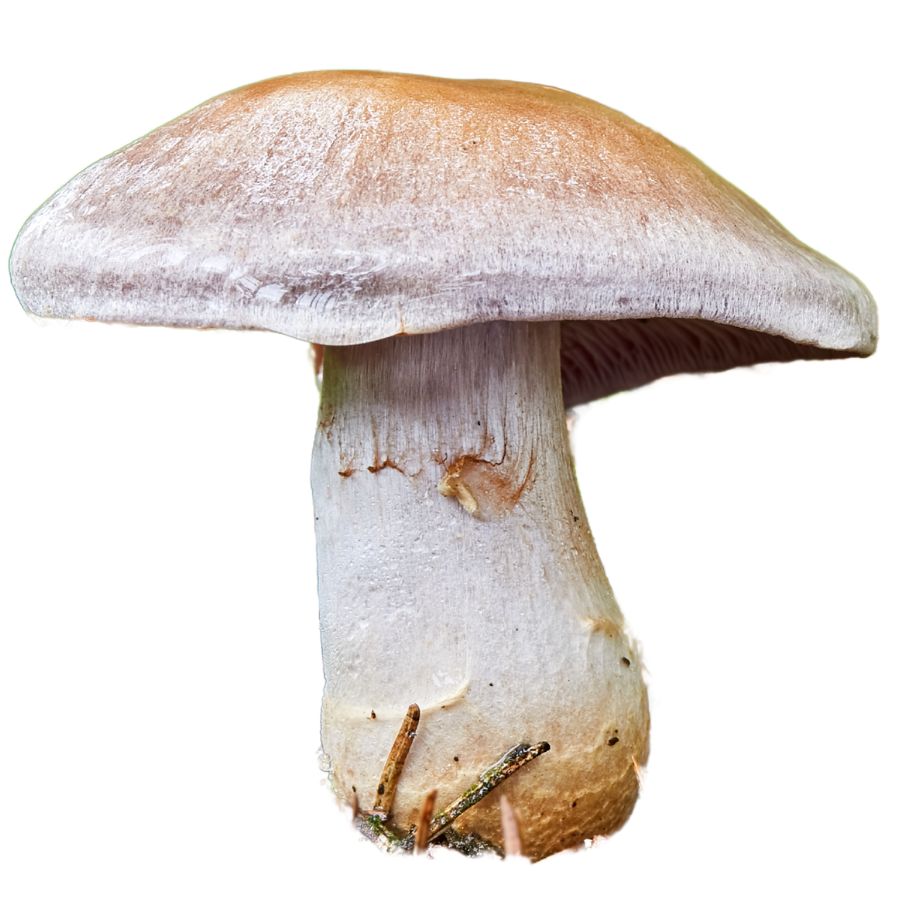
Often mistaken for: Blewits (Lepista nuda)
The lilac brown cort is a stocky mushroom with a violet to lilac cap that fades to brown as it ages, and a thick stem that often has rusty streaks from its spore dust. It gives off a strong, unpleasant odor that’s sometimes described to be similar to rotting laundry or rubber.
This mushroom is inedible and potentially toxic, with compounds that may harm the kidneys over time. It’s not considered deadly, but eating it can lead to serious long-term health problems if consumed in quantity.
Pigskin Poison Puffball (Scleroderma citrinum)
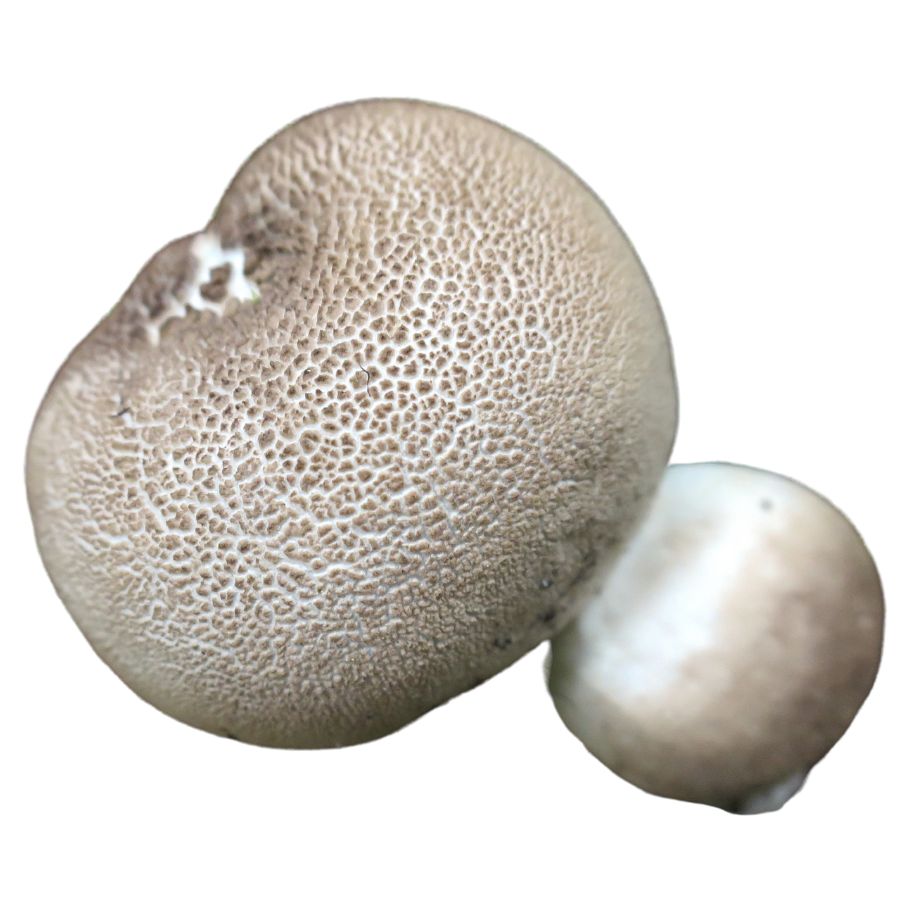
Often mistaken for: Common puffball (Lycoperdon perlatum)
The pigskin poison puffball is a round, tough-skinned mushroom with a warty, speckled surface that can be yellowish to brown. When cut open, the inside is dark purplish-black, even when young, and never pure white.
This mushroom is inedible and toxic, causing nausea, vomiting, and other digestive issues if eaten. The name “pigskin” is fitting—it’s thick, rubbery, and a good sign to leave it alone.
How to Find Edible Mushrooms in the State
Knowing how to recognize promising habitats is key to finding edible species consistently. Different mushrooms prefer different environments, so understanding regional ecosystems, seasonal shifts, and habitat markers can help you locate fruitful spots faster.
Focus on Hardwoods and Conifers
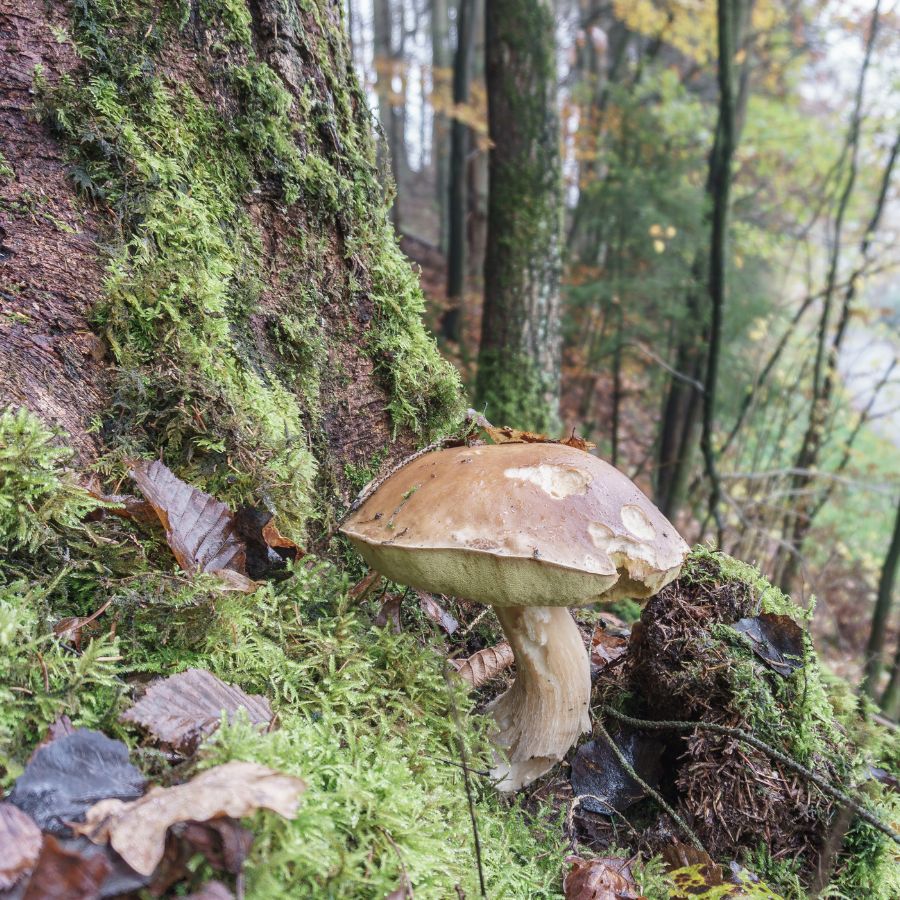
Many prized edible mushrooms grow in symbiosis with certain trees. Morels, for example, are often found near dead or dying elms, ash, sycamores, or old apple orchards. Chanterelles favor hardwood forests with oaks and beeches, while porcini are commonly linked to pines and spruces.
Mixed woodlands tend to offer the most variety. Areas with both conifers and deciduous trees often support overlapping species that fruit in different parts of the season. Pay attention to forest age as well, as mature woods with minimal underbrush are generally more productive than overgrown thickets.
Look Near Moss, Leaf Litter, and Stream Banks

Moisture plays a big role in where mushrooms fruit. Low-lying areas that retain water but don’t flood are especially good after recent rains. Mossy patches, seeps, and forested stream banks often support dense flushes of mushrooms. However, too much standing water or swampy terrain can favor molds and rot rather than edible fungi.
Look for slopes that receive filtered sunlight and have leaf litter, decaying wood, and rich soil. These spots hold humidity well without being saturated. South-facing hillsides may dry out too quickly, while north-facing ones tend to stay cool and damp longer.
Look in Burn Sites, Logging Sites, and Old Homesteads

Some mushrooms thrive in disturbed habitats. Morels in particular often appear in the first or second spring after a forest fire. Burned pine or mixed conifer areas in the Western US are well-known hotspots for black morels. Logging areas, floodplains, and even old homesteads with disturbed soil can also produce mushrooms.
Search around the edges of burned zones rather than in the center. Slightly scorched areas with remaining tree cover tend to be the most productive. Keep in mind that some species that fruit in disturbed areas appear quickly and then disappear just as fast.
Foraging isn’t just a pastime—it’s a skill that can help you get through the unexpected. Knowing how to forage for survival can turn wild plants into life-saving resources.
Track Rain and Temperature to Time Your Hunt
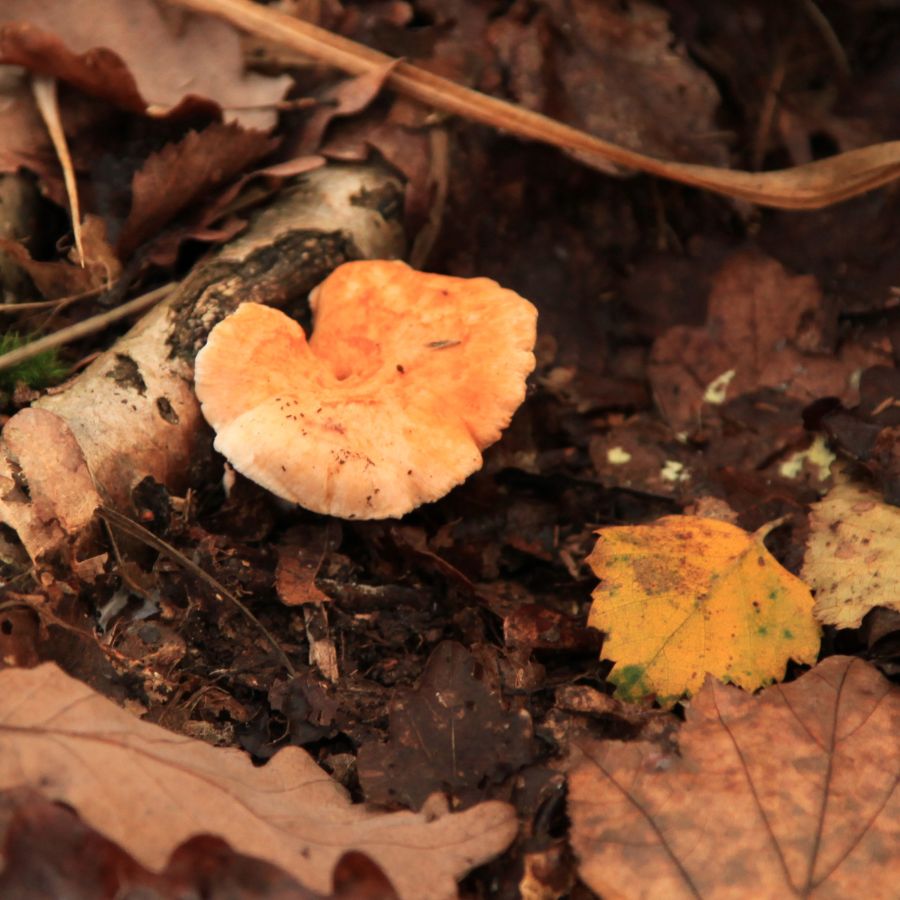
Timing is everything in mushroom foraging. Coastal states like California and Oregon may see chanterelles and hedgehogs during the wet winter months, while morels appear in springtime across much of the Midwest and Northeast. In mountainous regions, elevation plays a major role—start low in early spring and move higher as the season progresses.
Snowmelt often triggers fruiting in alpine zones. In places like Colorado or Utah, late spring and early summer are ideal for high-altitude species. Track temperature and rainfall patterns to adjust your search elevation accordingly.
You can find more wild spring edibles that are some of the first—and best—plants to forage each year.
Search Along Forest Borders, Fallen Logs, and Game Paths
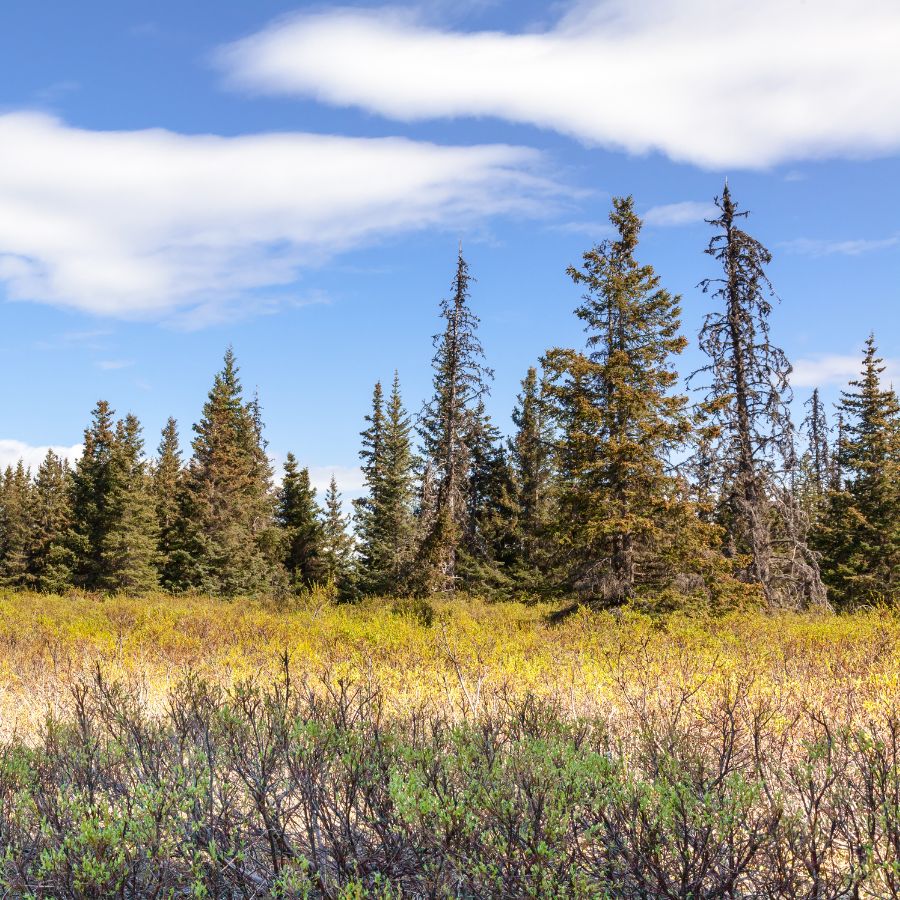
The edge between two environments, like a forest meeting a meadow, is often more productive than either area alone. These transition zones create a variety of light, moisture, and soil conditions that support different fungi. Old trails, game paths, and fallen logs also form microhabitats worth checking.
Keep an eye out for subtle clues like insect activity, animal scat, or clusters of saplings—these often indicate rich, undisturbed organic matter below. Fungi thrive where decay, diversity, and moisture converge, so train yourself to spot those overlaps.
Start With Familiar Mushroom Species

If you’re just starting out, pick one or two edible mushrooms that grow in your region and take the time to study them closely. Learn how they look in different stages of growth, what kind of environments they prefer, and what other mushrooms they might be confused with.
Don’t rely on just one photo or app to make an identification. Use field guides, online forums, and regional books together to cross-check what you’ve found and avoid mistakes.
These easy-to-identify edible mushrooms are easiest to spot and safest to harvest.
Learn the Right Tools and Techniques for Mushroom ID
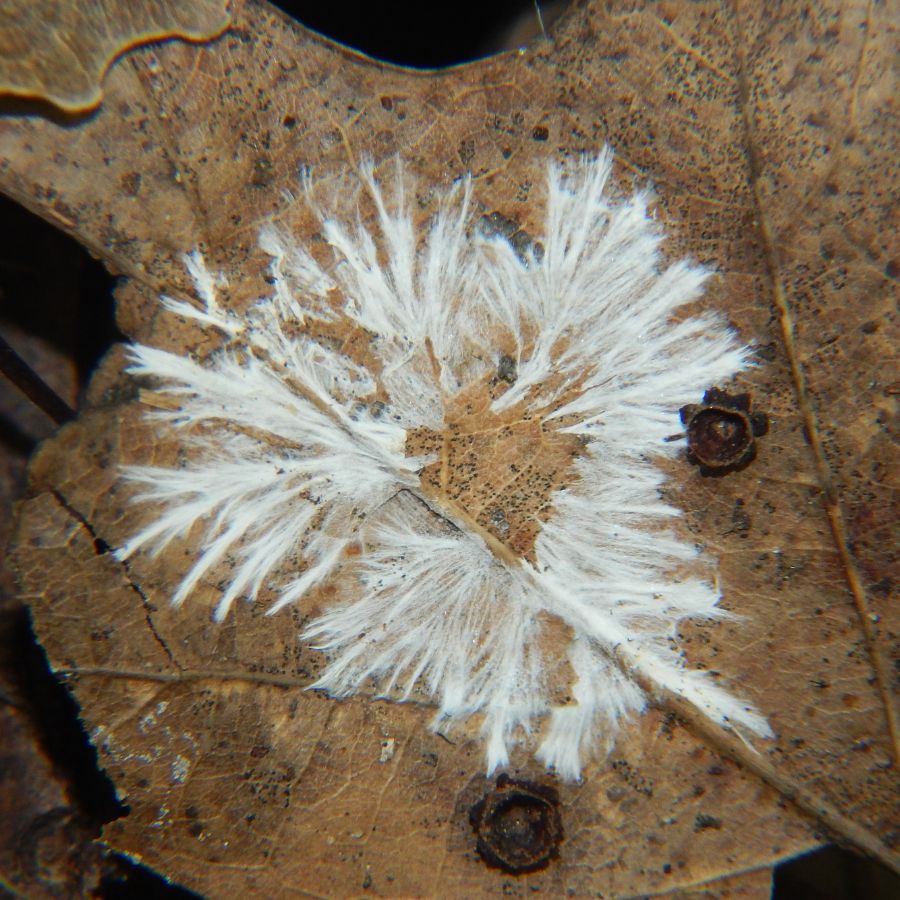
Accurate mushroom identification takes more than a quick glance or a smartphone scan. Learn how to take spore prints and pay close attention to gill attachment, cap texture, stem shape, and color changes.
Some mushrooms look nearly identical but differ in key microscopic or structural details. Old myths like “if animals eat it, it’s safe” or “white mushrooms aren’t poisonous” can lead to serious mistakes and should never be trusted.
A few simple foraging tools can help you gather more, damage less, and stay prepared in the field.
Only Eat Mushrooms You Can Identify With Absolute Certainty

If you’re not completely sure about a mushroom, it’s best to leave it behind. A single bite of the wrong species can lead to serious illness or even be fatal.
Many toxic mushrooms closely mimic popular edible ones, and the differences can be subtle. Learn which poisonous species grow in your area so you can recognize them before you ever pick.
Forage Away from Roads, Lawns, and Industrial Sites

Mushrooms can soak up heavy metals, pesticides, and other pollutants from the ground where they grow. Stay away from roadsides, treated lawns, or any area near industrial activity.
If you choose to eat foraged mushrooms, always save a few raw pieces in a paper bag in the fridge. This can help doctors quickly identify the species if you start to feel sick.
You don’t have to go too far if you want to forage safely. You might be surprised how many edible suburban plants are hiding in plain sight around your neighborhood.
Check Local Foraging Rules Before You Start Collecting

Before collecting mushrooms, make sure to check the rules for the area you’re in—some public lands allow foraging, while others don’t. Regulations can vary widely between parks, forests, and preserves.
Spending time with experienced foragers can teach you things that books and photos don’t show. Local mushroom clubs and guided walks are great ways to build your skills and confidence.
A little knowledge goes a long way when it comes to safely harvesting wild food.
Before you head out
Before embarking on any foraging activities, it is essential to understand and follow local laws and guidelines. Always confirm that you have permission to access any land and obtain permission from landowners if you are foraging on private property. Trespassing or foraging without permission is illegal and disrespectful.
For public lands, familiarize yourself with the foraging regulations, as some areas may restrict or prohibit the collection of mushrooms or other wild foods. These regulations and laws are frequently changing so always verify them before heading out to hunt. What we have listed below may be out of date and inaccurate as a result.
Best Locations for Edible Mushrooms in the State
Some of the best spots for edible mushrooms are tied to very specific conditions. Knowing where to look and what typically grows in different locations can help narrow down your search.
Here are more of the state’s edible mushrooms and where you’re most likely to find them:
| Location | Edible Mushroom Species |
| Ocala National Forest – Seminole RD Area | American Caesar’s Mushroom (Amanita jacksonii), Short-stemmed Slippery Jack (Suillus brevipes), Gem-Studded Puffball (Lycoperdon perlatum) |
| Ocala National Forest – Lake George RD Area | Chestnut Bolete (Gyroporus castaneus), Smooth Chanterelle (Cantharellus lateritius), Bear’s Head Tooth (Hericium americanum) |
| Ocala National Forest – Juniper Springs Area Trails | White-Pored Chicken of the Woods (Laetiporus cincinnatus), Velvet Foot (Flammulina velutipes), Wood Ear (Auricularia americana) |
| Ocala National Forest – Alexander Springs Area Trails | Bay Bolete (Imleria badia), Oyster Mushroom (Pleurotus ostreatus), Ringless Honey Mushroom (Armillaria tabescens) |
| Apalachicola National Forest – Apalachicola RD Area | Beefsteak Fungus (Fistulina hepatica), Southern Chanterelle (Cantharellus texensis), Hen of the Woods (Grifola frondosa), Old Man of the Woods (Strobilomyces strobilaceus) |
| Apalachicola National Forest – Wakulla RD Area | Field Blewit (Lepista saeva), Comb Tooth (Hericium coralloides), Pale Chanterelle (Cantharellus tabernensis) |
| Apalachicola National Forest – Camel Lake Area Trails | Prince (Agaricus augustus), Lion’s Mane (Hericium erinaceus), Black Trumpet (Craterellus fallax) |
| Apalachicola National Forest – Wright Lake Area Trails | Horse Mushroom (Agaricus arvensis), Slippery Jack (Suillus luteus), Golden Chanterelle (Cantharellus cibarius) |
| Osceola National Forest – Ocean Pond Area Trails | Hedgehog Mushroom (Hydnum repandum), Chicken of the Woods (Laetiporus sulphureus), Golden Ear (Tremella aurantia), Zeller’s Bolete (Xerocomellus zelleri) |
| Blackwater River State Forest | Giant Lactarius (Lactarius indigo), Common Split Gill (Schizophyllum commune) |
| Withlacoochee State Forest – Citrus Tract) | Deer Mushroom (Pluteus cervinus), Pear-Shaped Puffball (Lycoperdon pyriforme) |
| Withlacoochee State Forest – Croom Tract) | Dryad’s Saddle (Cerioporus squamosus), Puffball (Calvatia gigantea) |
| Tate’s Hell State Forest | Shaggy Mane (Coprinus comatus), Meadow Mushroom (Agaricus campestris), Golden Spindle (Clavulinopsis fusiformis) |
| Lake Wales Ridge State Forest | Yellowfoot (Craterellus tubaeformis), Cauliflower Mushroom (Sparassis americana) |
Peak Mushroom Seasons
Mushroom seasons follow familiar patterns, but timing still depends heavily on local conditions. Soil moisture, temperature swings, and even wind patterns can all influence when species start to fruit.
Year-round
Some edible mushrooms in Florida can be foraged throughout the year thanks to the state’s warm, humid climate:
| Mushroom | Months | Best Weather Conditions |
| Common Split Gill (Schizophyllum commune) | All Year | Consistent humidity on dead wood |
| Deer Mushroom (Pluteus cervinus) | All Year | Moist decaying logs in shaded woods |
Spring
As temperatures rise and moisture returns, a variety of edible mushrooms begin to fruit in forests and fields:
| Mushroom | Months | Best Weather Conditions |
| Dryad’s Saddle (Cerioporus squamosus) | March–May | Damp spring air, recently rain-soaked logs |
| Morel (Morchella esculenta) | March–April | Post-cold front warmup, moist soil |
| Yellow Morel (Morchella americana) | March–April | Moist hardwood ground, after rain and warmth |
Summer
Summer foraging can be productive, with certain mushrooms favoring the warmer conditions of the season:
| Mushroom | Months | Best Weather Conditions |
| American Caesar’s Mushroom (Amanita jacksonii) | June–August | Humid oak-pine forests after rain |
| Chicken of the Woods (Laetiporus sulphureus) | May–September | After heavy rain on warm, humid days |
| Golden Chanterelle (Cantharellus cibarius) | June–September | Warm, humid weather after sustained rains |
| Pale Chanterelle (Cantharellus tabernensis) | July–September | Wet pinewoods after summer thunderstorms |
| Smooth Chanterelle (Cantharellus lateritius) | June–September | Moist soil, high humidity, frequent summer storms |
| Southern Chanterelle (Cantharellus texensis) | June–August | Humid conditions with rain and warm temps |
| White-Pored Chicken of the Woods (Laetiporus cincinnatus) | June–September | Base of hardwoods after rains |
| Chestnut Bolete (Gyroporus castaneus) | July–September | Warm, wet spells in sandy soil |
| Giant Lactarius (Lactarius indigo) | July–October | Moist oak-pine woodlands with recent rain |
| Old Man of the Woods (Strobilomyces strobilaceus) | July–October | Damp forest floors post-rain |
Fall
Fall is a great season for many edible mushrooms, with cool temperatures and steady moisture creating ideal conditions:
| Mushroom | Months | Best Weather Conditions |
| Bay Bolete (Imleria badia) | September–November | Moist acidic soils after rainfall |
| Bear’s Head Tooth (Hericium americanum) | October–December | Cool temps, damp hardwood logs or stumps |
| Beefsteak Fungus (Fistulina hepatica) | September–November | Damp hardwoods, especially oaks |
| Cauliflower Mushroom (Sparassis americana) | September–November | Moist pine woods, post-rainfall cooling |
| Comb Tooth (Hericium coralloides) | October–December | Wet, shaded hardwood forest after rain |
| Elm Oyster (Hypsizygus ulmarius) | October–December | Moist logs in cool, shaded spots |
| Gem-Studded Puffball (Lycoperdon perlatum) | September–November | Humid weather, leaf litter moisture |
| Golden Spindle (Clavulinopsis fusiformis) | September–November | Damp grass or moss in woods |
| Hen of the Woods (Grifola frondosa) | October–November | Cool temps and recent rain, around oaks |
| Horse Mushroom (Agaricus arvensis) | September–November | Grassy meadows, humid but not saturated |
| Meadow Mushroom (Agaricus campestris) | September–November | Moist grasslands after rain |
| Pear-Shaped Puffball (Lycoperdon pyriforme) | September–November | Moist forest logs, humid afternoons |
| Prince (Agaricus augustus) | September–November | Damp forest duff, often after rain |
| Puffball (Calvatia gigantea) | September–November | Damp fields or meadows after rain |
| Shaggy Mane (Coprinus comatus) | October–November | Cool nights, wet lawns or disturbed ground |
| Short-stemmed Slippery Jack (Suillus brevipes) | October–December | Moist pine duff after rain, cooler temps |
| Slippery Jack (Suillus luteus) | October–December | Rainy weather, especially in pine woods |
| Zeller’s Bolete (Xerocomellus zelleri) | September–November | Moist oak-pine mix woods |
| Golden Ear (Tremella aurantia) | October–February | Humid conditions, on hardwood logs with Stereum |
| Lion’s Mane (Hericium erinaceus) | October–February | Cool, damp conditions with decaying logs |
| Oyster Mushroom (Pleurotus ostreatus) | October–February | High humidity and rain on fallen hardwood |
| Witches’ Butter (Tremella mesenterica) | October–February | Moist air and rain on deadwood |
| Black Trumpet (Craterellus fallax) | November–February | Cool, wet weather with consistent moisture |
| Ringless Honey Mushroom (Armillaria tabescens) | August–October | Warm soil, recent rainfall, hardwood roots |
Winter
While many species go dormant, a few hardy mushrooms can still be found in the woods during winter:
| Mushroom | Months | Best Weather Conditions |
| Field Blewit (Lepista saeva) | December–February | Cold snaps with damp fields |
| Hedgehog Mushroom (Hydnum repandum) | December–February | Cold fronts with high humidity, moist ground |
| Velvet Foot (Flammulina velutipes) | December–February | Cold spells with moisture, fallen logs |
| Wood Ear (Auricularia americana) | November–February | Damp wood, cool humid air |
| Yellowfoot (Craterellus tubaeformis) | December–February | Cool, damp conditions in shaded woods |
One Final Disclaimer
The information provided in this article is for general informational and educational purposes only. Foraging for wild plants and mushrooms involves inherent risks. Some wild plants and mushrooms are toxic and can be easily mistaken for edible varieties.
Before ingesting anything, it should be identified with 100% certainty as edible by someone qualified and experienced in mushroom and plant identification, such as a professional mycologist or an expert forager. Misidentification can lead to serious illness or death.
All mushrooms and plants have the potential to cause severe adverse reactions in certain individuals, even death. If you are consuming foraged items, it is crucial to cook them thoroughly and properly and only eat a small portion to test for personal tolerance. Some people may have allergies or sensitivities to specific mushrooms and plants, even if they are considered safe for others.
Foraged items should always be fully cooked with proper instructions to ensure they are safe to eat. Many wild mushrooms and plants contain toxins and compounds that can be harmful if ingested.

